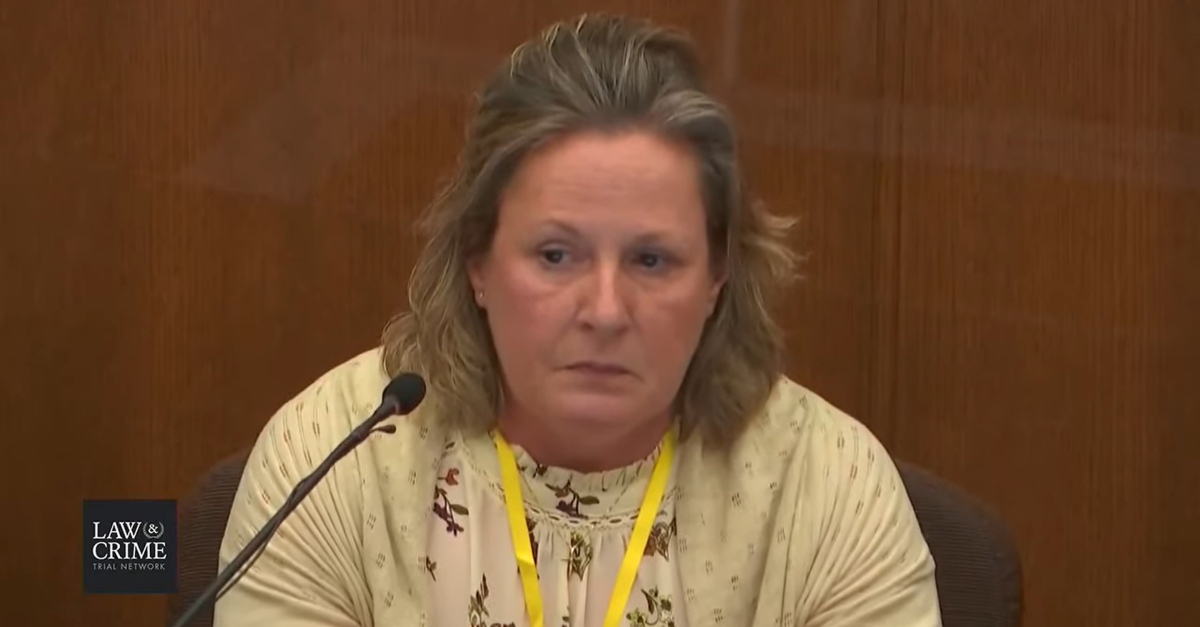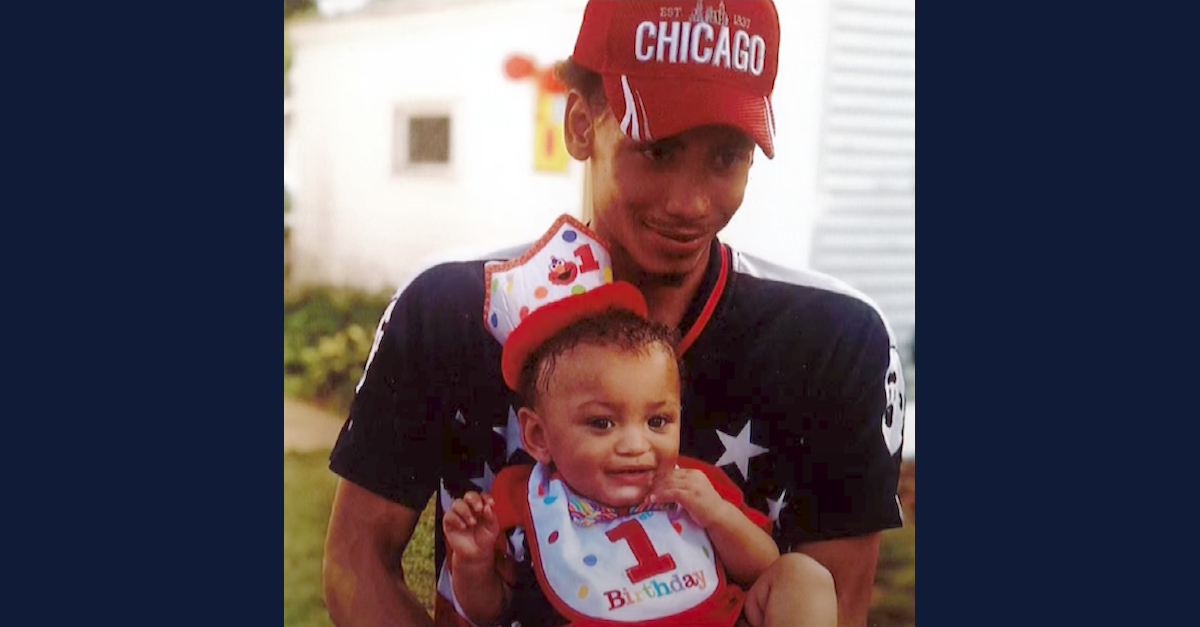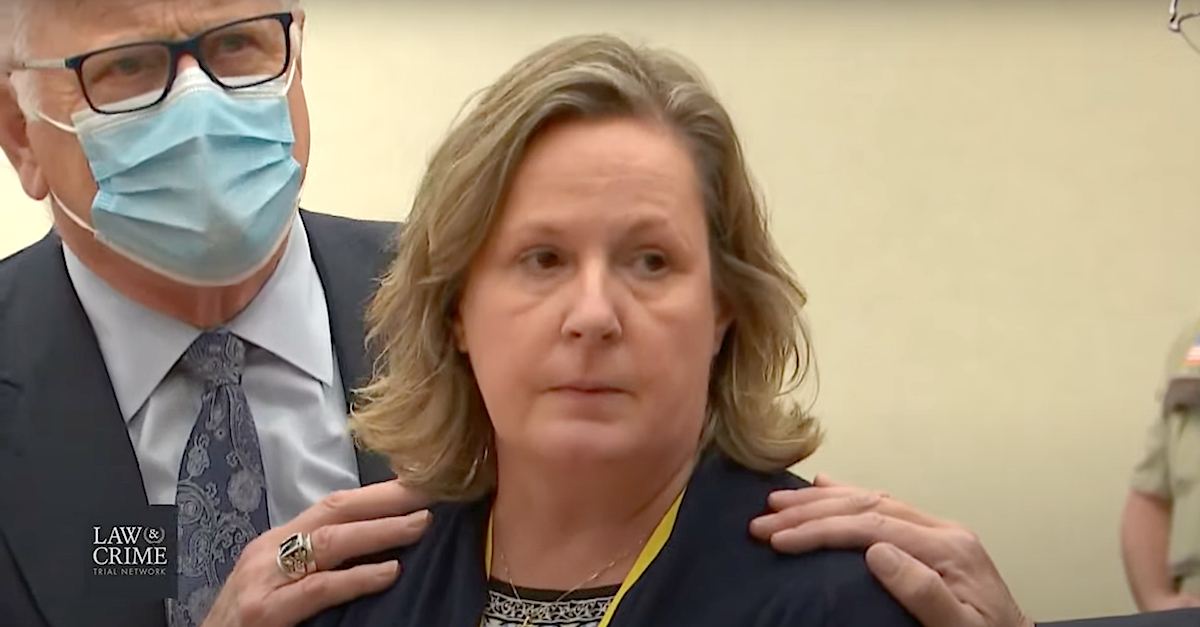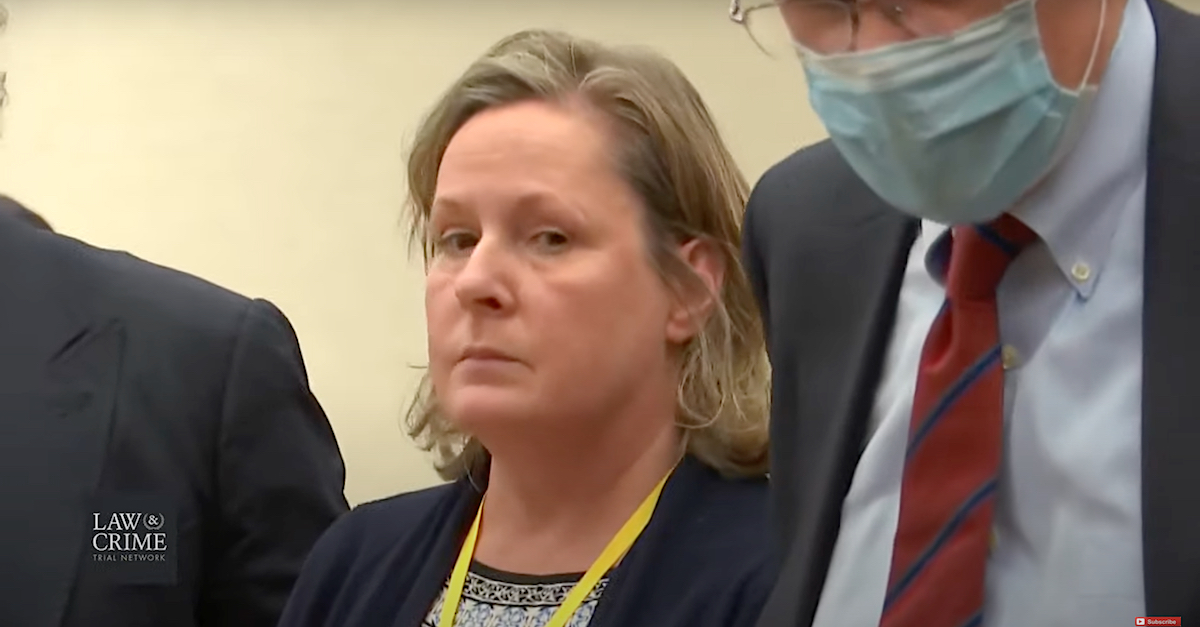
Kim Potter testifies during her criminal trail.
Jurors in Hennepin County, Minnesota, found former police officer Kimberly Ann Potter, 49, guilty of both first-degree manslaughter and second-degree manslaughter for shooting and killing Daunte Wright, 20, during a catastrophic April 11, 2021 traffic stop.
There was never any dispute that Potter killed Wright. The incident was caught on police body camera video, which showed Wright beginning to resist Officer Andrew Luckey’s attempt to arrest Wright over a misdemeanor warrant. Wright got back into the driver’s seat of his car. Potter pulled out her gun but identified it repeatedly as a Taser. After yelling that she would Tase Wright, Potter pulled the trigger of her service weapon and shot Wright in the chest. The dying man, who prosecutors said was struck in the heart, drove off and crashed down the street.
According to the body camera video, Potter immediately recognized her fatal error.
“I grabbed the wrong fucking gun!” she screamed out. “I shot him! Oh, my God! Oh, my God! Oh, my God! Oh, my God!”
Potter resigned soon after the shooting.

Prosecutors showed an image of police shooting victim Daute Wright during opening statements in the trial of ex-Brooklyn Center, Minn. Officer Kimberly Potter on Dec. 8, 2021. (Image via a slide used during prosecution opening statements.)
Prosecutors placed the responsibility for Wright’s death on Potter.
“It was a tragedy of her own making,” Assistant Attorney General Erin Eldridge told the jury.
No one was in any danger of being dragged off or almost dragged off by Wright, the prosecutor argued Monday. Police Sgt. Mychal Johnson had grabbed Wright’s right arm, preventing him from driving, Eldridge claimed. Potter, a well-trained 26-year police veteran, nonetheless freed up her right hand — her gun hand — and pulled her firearm even though she was standing behind Luckey at the driver’s side of Wright’s vehicle and did not have a clear view of what was happening.
Potter pulled the trigger with Johnson and car passenger Alayna Albrecht–Payton in the line of fire, Eldridge told the jury. Potter’s gun was so close to Luckey that the shell casing struck him in the face, the prosecutor continued. All told, the state maintained that Potter was well trained and should have known better.
NOW: Matthew Frank with the state’s rebuttal closing argument: “Members of the jury, #DaunteWright was shot to death by a gun in the hand of a highly trained police officer veteran.” He says that’s what the case is about no matter how hard the defense tries to distract from that pic.twitter.com/havjdLHCMm
— Cathy Russon (@cathyrusson) December 20, 2021
Wright caused the fatal confrontation by resisting and putting officers in danger, Potter’s attorney Earl Gray told jurors.
“That’s the cause, ladies and gentlemen,” he said. “That’s what caused this whole incident.”
Gray asserted that prosecutors misrepresented the evidence by playing back the body cam footage in slow motion. Gray described everything happening in mere seconds, from Wright’s attempt to resist arrest to Potter’s pull of the trigger.
“It was chaos,” he said.

Former Brooklyn Center, Minn. police officer Kimberly Ann Potter appears in twin mugshots taken shortly after the shooting.
Gray dismissed the state’s assertion that Wright was not a danger. The defense argued that Wright could have dragged and seriously injured Johnson, whose hand and arm were in the car attempting to prevent Wright from fleeing. Johnson said as much on body camera video shortly after the shooting; prosecutors said he was trying to cook up a story to cover for Potter.
Gray acknowledged his client made a mistake by pulling her gun from the right side of her duty belt, rather than he Taser from the left side of her duty belt, but said that Potter could not have recklessly handled a gun under the law because she did not know she was holding one.
#KimPotterTrial – Defense closing: Reckless use of a firearm: Defintion is committs a “conscious” or “intentional” act. Gray: Conscious means being aware…there’s no evidence that she knew she had the gun in her hand. #DaunteWright @LawCrimeNetwork pic.twitter.com/m0UpTSaSEm
— Cathy Russon (@cathyrusson) December 20, 2021
The defense also spent a significant amount of time reminding jurors that Potter and her fellow officers had a legal duty to take Wright into custody because of the outstanding warrant. They could have have simply let him go because that would have been a defiance of an order of a court, the defense said repeatedly during the trial.
Potter testified that she couldn’t remember most of the aftermath of the shooting — including her statements captured on body cam video and audio recordings — because she was in shock.
When she was repeatedly berated by prosecutors for sitting on a curb crying rather than immediately rushing to attempt to aid Wright, Potter broke down.
“I’m sorry it happened,” a shaking and sobbing defendant blurted out from the witness stand. “I’m so sorry.”

Kim Potter’s attorneys comforted their client seconds before Judge Regina M. Chu read two guilty verdicts. (Image via screengrab from the Law&Crime Network.)
Potter was initially charged with second-degree manslaughter. Prosecutors later added a count of first-degree manslaughter to the case against the former officer.
To convince the jury of the highest count, first-degree manslaughter, the state was required to prove that Potter caused Wright’s death during the commission of a lesser offense. Here, the lesser alleged offense was the reckless handling or use of a firearm. That lesser offense had to be proven in full and beyond a reasonable doubt as follows, according to the jury instructions the judge read before deliberations. Notably, the state was required to prove that Potter’s actions were a “conscious and intentional” act:
(1) First, the Defendant recklessly handled or used a firearm. A person acts “recklessly” if, under the totality of the circumstances, she commits a conscious or intentional act in connection with the handling or use of a firearm that creates a substantial and unjustifiable risk that she is aware of and disregards.
(2) Second, the Defendant handled or used the firearm so as to endanger the safety of another person.
Additionally, to elevate the charge to the level of manslaughter, the state had to prove beyond a reasonable doubt that Potter committed the underlying offense “with such force or violence that the death of another person or great bodily harm to another person was reasonably foreseeable.”
The second-degree manslaughter count required a slightly lesser calculation. To prevail, the state needed to prove that Potter caused the death of Daunte Wright by “culpable negligence.” That means Potter was alleged to have “created an unreasonable risk and consciously took a chance of causing death or great bodily harm.” The jury instructions pointed out the parameters of that calculation:
“Culpable negligence” is intentional conduct that the Defendant may not have intended to be harmful but that an ordinary and reasonably prudent person would recognize as involving a strong probability of injury to others.
Neither charge required the state to prove that Potter intended to kill Wright.

Kim Potter glances briefly toward a television camera after being convicted of first-degree and second-degree manslaughter. (Image via screengrab from the Law&Crime Network.)
After hearing the verdict, Potter’s attorneys asked that she be released from custody pending formal sentencing because she was “not a risk” to the community at large, because the conviction occurred two days before Christmas, and because Potter was “a devoted Catholic.” Judge Regina M. Chu said she would not treat Potter differently than other defendants and required Potter to be held behind bars pending a sentencing hearing in early 2022.
The full jury instructions, which explain the relevant Minnesota laws, are below.
[Screenshot via The Law&Crime Network]